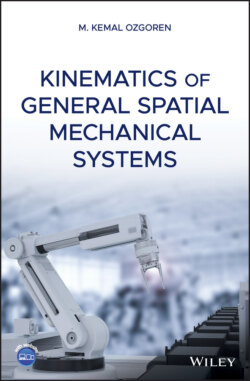Читать книгу Kinematics of General Spatial Mechanical Systems - M. Kemal Ozgoren - Страница 34
2.6 Orthonormality of the Rotation Matrices
ОглавлениеSuppose a vector is rotated into another vector . This operation is expressed by the following equation as observed in a reference frame .
(2.46)
Since a rotation operator does not change the magnitude of the vector it rotates, the following equations can be written.
(2.47)
Equation (2.47) implies that
(2.48)
Hence, Eq. (2.48) implies further that
(2.49)
Here, as a reminder from the matrix algebra, a matrix is defined to be orthonormal if its inverse is equal to its transpose, i.e. if . Therefore, according to Eq. (2.49), is an orthonormal matrix.
Owing to its orthonormality, the inverse of can be obtained by using Eq. (2.14), which is repeated below for the sake of convenience.
(2.50)
Note that and are symmetric matrices having their transposes equal to themselves but is a skew symmetric matrix, i.e. . Therefore, Eqs. 2.49 and 2.50 lead to the following result.
(2.51)
Referring to Eq. (2.26), Eq. (2.51) implies the following exponential expression.
(2.52)
Equations (2.51) and (2.52) show that the inverse of always exists. Therefore, its determinant never vanishes. In fact, it happens that
(2.53)
Equation (2.53) can be verified as explained below.
The matrix can be expressed as follows in terms of its columns:
(2.54)
Since the kth basic column matrix picks up the kth column of the matrix it multiplies, can be obtained as follows together with the interpretation that .
(2.55)
According to Eq. (2.55), represents a vector , which is obtained by rotating the basis vector of the reference frame by means of the rotation operator represented by .
Since is assumed to be a right‐handed reference frame, its basis vectors satisfy the following set of cross product equations.
(2.56)
Here, it must be pointed out that a rotation operator does not only retain the magnitudes of the vectors it rotates but it also retains the right‐hand rule for their cross products. Therefore, the vectors , , and , which are obtained by rotating , , and , also satisfy a set of equations similar to Eq. Set (2.56). That is,
(2.57)
In the frame , the matrix equivalent of Eq. Set (2.57) can be written as follows:
(2.58)
On the other hand, as shown in Example 1.3 of Section 1.8, the determinant of a matrix, e.g. , can be expressed as follows in terms of its columns, i.e. , , and :
(2.59)
According to Eq. Set (2.58), . Therefore, Eq. (2.59) becomes
(2.60)
At this point, by using Eq. (2.55), Eq. (2.60) can also be written as
(2.61)
Since is an orthonormal matrix, it obeys Eq. (2.48). That is,
(2.62)
Therefore, Eq. (2.61) leads to the verification that
(2.63)
